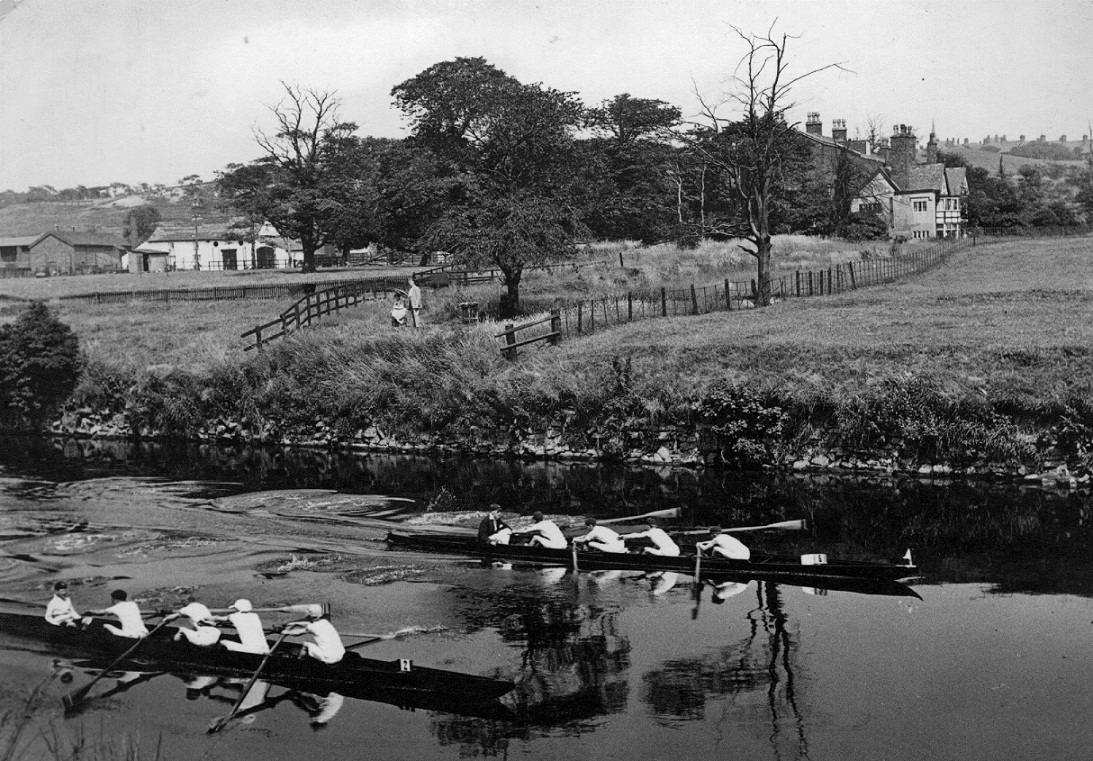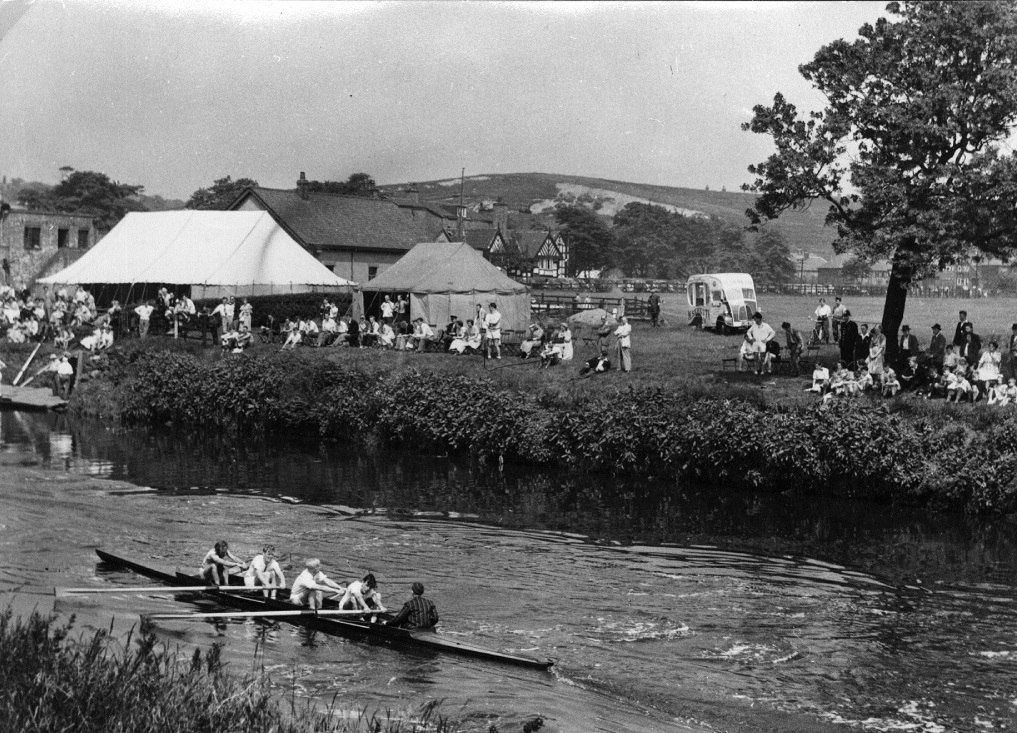Kersal Cell
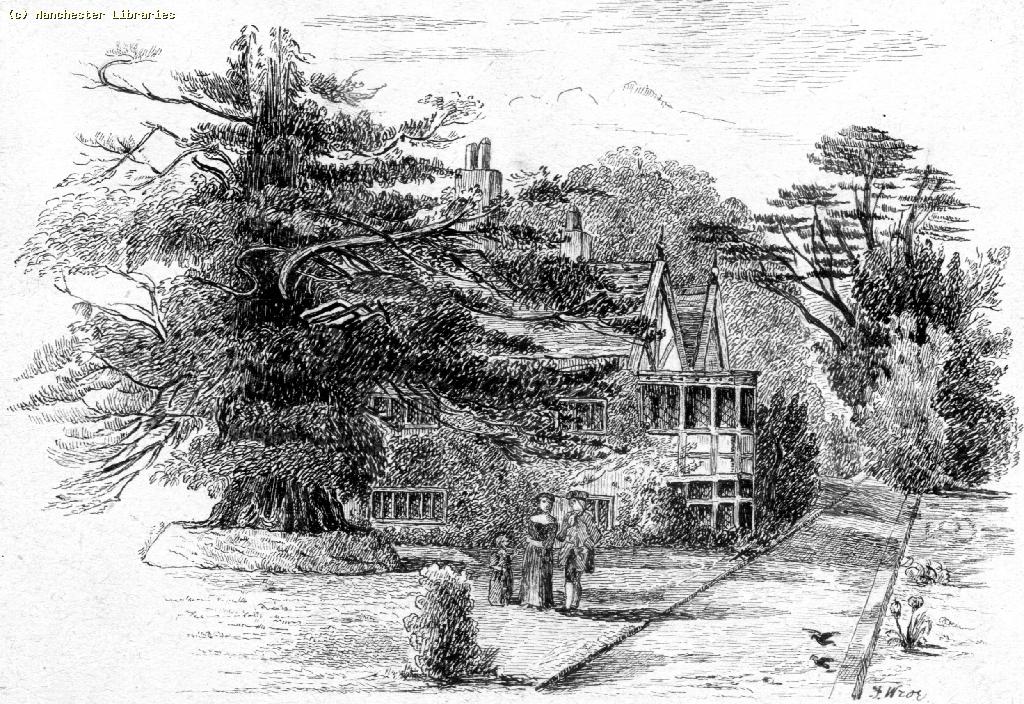
A painting of Kersal Cell from 1780 which is the second oldest building in Salford and was built in 1563
From heritage-explorer.co.uk
"This 16th century timber framed manor house is on the site of the 12th century Cluniac priory. The priorywas founded as a cell of Lenton prioryin c1145-53 by the Earl of Chester on the site of a hermitage. As a Cluniac it was dependent on La Charité-sur-Loire church in France, until 1392. The monks then had English citizenship until the priory was dissolved in 1538. The remaining building contains roof timbers dated dendrochronolgically to c1515. A wall painting was discovered behind the 17th century panelling, it has been dated to 1595-1605. Over 30 worked sandstone blocks were recovered in an excavation and are likely to have been part of the original Cluniac cell. The monastic buildings appear to have been removed at some point between 1755 and 1795. It is also associated with John Byrom (1692-1763), a shorthand writer, and author of the hymn 'Christians Awake'."
From English Heritage
"LITTLETON ROAD 949-1/2/69 (West side) 31/01/52 Kersal Cell GV II* Manor house, later restaurant, now disused. C16 with later additions. Timber-framed with plaster infill on a sandstone base. Welsh slate roof with axial and end wall stacks. EXTERIOR: 2 storeys, hall range with cross-wings. Originally a 4-bay cruck-framed building, the cross-wings added later. Framed in square panels, with coving below eaves, and braced king-post roof construction to gabled wings. Recent restorations have replaced window ranges in the S elevation, which has a continuous band of fenestration to the ground floor, and a long narrow window to first floor, all with timber mullions. Doorway inserted to left of right-hand gable, which has renewed 5-light mullioned window to right, and canted oriel window above. Full-height canted bay window in left-hand gable. The N elevation is of painted brick with Gothic style windows in stuccoed square hoodmoulds. Exposed cruck trusses built into end walls with part of a restored plaster frieze with bold decoration to the left comprising a bordered panel with vine leaves, fleur-de-lys and escutcheon with initials E B and date 1697. To the right are 3 moulded devices with large unicorn supporters. C17 staircase with intertwined twisted balusters. HISTORICAL NOTE: the house stands on the site of Lenton Priory, a C12 Cluniac house. It was the home of John Byrom, shorthand writer, and author of 'Christians Awake'."
From: 'Townships: Broughton', A History of the County of Lancaster: Volume 4 (1911)
"The house now called Kersal Cell occupies the site of the old religious house. It is a small two-story building of timber and plaster, much altered from time to time, but probably dating from the middle or end of the 16th century. It stands on low ground near a bend of the River Irwell, facing south, with the heights of Broughton and Kersal Moor immediately to the north and east. In more recent times a large brick addition has been made on the north, and extensions have also been made on the east in a style meant to harmonize with the timber front of the older part. The original house, which possibly is only a fragment of a larger building, has a frontage of about 56 ft. and consists of a centre with a projecting wing at each end. The west wing has a bay window in each floor, but the east wing has an eight-light window and entrance doorway on the ground floor and a slightly projecting bay above. Both wings have gables with barge boards and hip knobs, but the timber construction is only real up to the height of the eaves, the black and white work in the gables being paint on plaster. This is also the case with the east end and the whole of the front of the later extension on the same side. The roofs are covered with modern blue slates, and the west end is faced with rough-cast. The general appearance at a distance is picturesque, but at close view the house is too much modernized to be wholly satisfactory, and it is dominated by the brick building on the north, whose roof stands high above that of the older portion.
In the interior, however, Kersal Cell preserves some interesting features, many of the rooms being panelled in oak and some good plaster-work remaining. The ground floor is now below the level of the garden, the ground apparently having risen something like 3 ft. The plan has been a good deal altered to suit modern requirements, but preserves a centre apartment or hall about 18 ft. long with a seat against its west wall, which is oak-panelled for 6 ft., and has an ornamental plaster frieze. The lower room in the east wing has oak panelling all round to a height of 7 ft., and in one of the upper lights of the window is a circular piece of heraldic glass with the arms and name of Avnesworthe. The lower room in the west wing has a bay window 8 ft. 8 in. across and 5 ft. 6 in. deep. The lead lights in this and in other rooms of the house are of good geometrical patterns, and in one of the upper lights of the bay is an interesting glass sundial so fixed that the shadow is visible from the inside. The staircase is of Jacobean date with square oak newels and open twisted balusters, now varnished. It goes up to the top of the house, which in the centre has an attic. The most interesting room, however, is that usually called the chapel, on the first floor at the west end. It is a small room about 18 ft. long and 13 ft. wide with a five-light window facing west. It occupies the rear portion of the west wing, the room in front with its bay window being sometimes known as the priest's room. What authority there is for these names does not appear, and at present the only indication of the back room having been used for religious purposes is a small square of 17th-century glass in the window depicting the crucifixion. The two side lights of the window are plain, but the three centre ones contain fragments of 16th-century heraldic glass. In the second light is a shield, with the arms of Ainsworth, with helm, crest, and mantling. The centre light has two small diamond quarries in brown stain, over the crucifixion already mentioned. On a beam in front of the window is an elaborate plaster frieze with three shields of arms, somewhat similar to those at Slade Hall, Rusholme. The centre shield bears the royal arms (France quartered with England) with crown and supporters, dexter a lion, sinister a dragon. The left-hand shield is of six quarterings, encircled by a garter, and originally with crest and supporters, but the dexter support and the crest have been cut away, when the plaster panel over the angle fireplace was inserted. The arms are those of Ratcliffe, Earl of Sussex, who quartered FitzWalter, Burnel, Botetourt, Lucy, and Multon of Egremont with his paternal coat.
The right-hand shield has the arms of Stanley, Earl of Derby, encircled by a garter, with crest (eagle and child) and supporters. There is a frieze in the south wall apparently of the same date with Tudor roses and fleurs-de-lys. Over the angle fireplace is a plaster panel of later date, with a shield bearing the arms of Byrom (a cheveron between three hedgehogs) with crest (a hedgehog), and the initials E. B. over. On each side of the shield is a fleur-de-lys, and below is the date 1692. The south and part of the north wall are panelled to the height of 6 ft. in oak, and the door is set across the south-east angle, balancing the fireplace.
There is a tradition that Dr. Byrom wrote 'Christians, Awake' in Kersal Cell, and that it was first sung in front of the house on Christmas Eve 1750, but both events are more likely to have taken place at Byrom's house in Manchester."
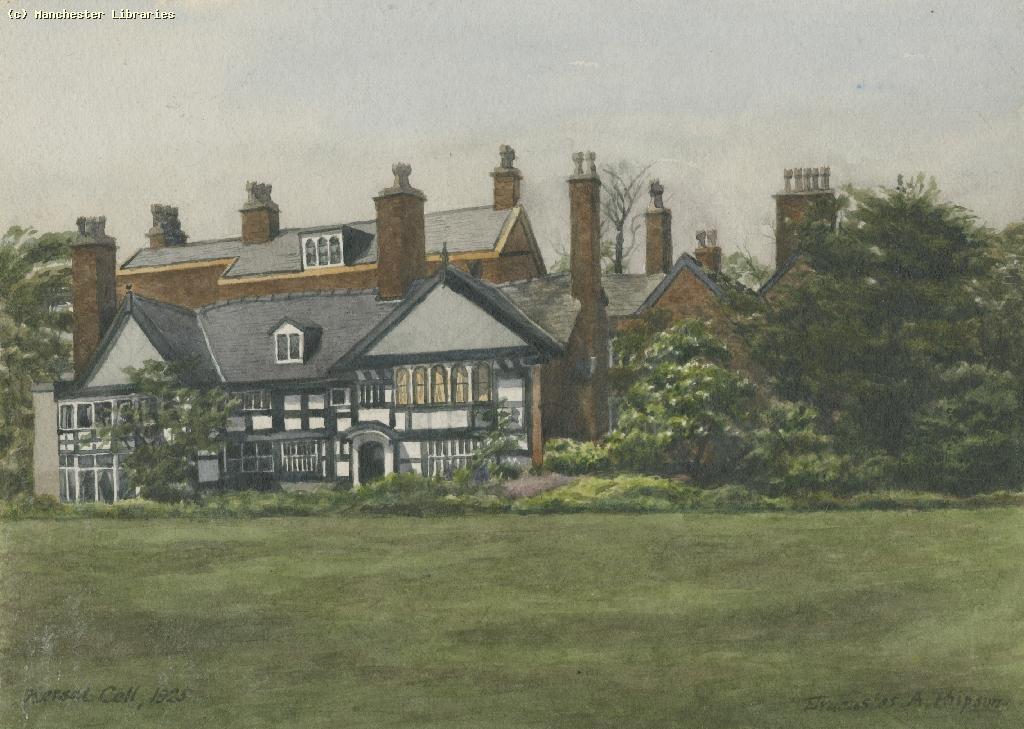
A painting of Kersal Cell in 1925.
A Visit to Kersal Cell (From an article written by Charles Henry Stott for the Oldham Express some time in the 1870s.)
In the immediate neighbourhood of large cities and towns ancient residences are only few; old churches and other ecclesiastical buildings may be seen in n almost every locality. But the march of modern progress with constantly extending railways and other wonderful and progressive achievements make ancestral residences, when the moderniser has so decided, to instantly disappear.
Ancient buildings, whether ecclesiastic or civic, are always interesting and when there is no difficulty in in getting to tee them, are an immense attraction. “Old London” at the “Fisheries” “Inventions” etc, draw 100’s of spectators. The continuous and anxious inquiry of friends being “Have you seen Old London?” But “Old London” á ces expositions was not a reality, it was a copy, an imitation. Old London had long ago disappeared and this was a repetition, the work of modern ingenuity, which had been made to attract, to draw, to please; yet there are ancient habitations now, some almost in our midst. One of these is Kersal Cell, at Higher Broughton, hear Manchester, which was originally built on the site of an old monastery of Cluny monks, which being one of the richest monastic establishments in Lancashire was sequestered, with many other by King Henry the Eighth. It was rebuilt in the year 1600, and is now used as a ladies’ boarding school, under the direction of Mrs Mary BARBOUR.
Kersal Cell is within four miles of Manchester Royal Exchange, yet its rural surroundings make the distance very deceptive. The boarders, however, have the advantage in their juvenility of the rural surroundings and as this ancient building is the centre of an area of six acres of garden and meadow land, with dairy farm, the produce of which is for the use of the school, the pupils have an additional advantage. As we are writing of the Cell as we found it, its olden history is best told in the following lines:
Dear famous, time-worn Kersal Cell,
That nestling lay in woodland dell
For years, far4 more than we can tell,
When monks of Kirkshaw loved it well,
And under these ancestral trees,
Feasting on mead, black bread and cheese,
Spent far more time than on their knees.
Here scarce three hundred years ago
Brave cavaliers marched to and fro
To guard these homes from Roundhead foe.
And Bonnie Charlie Scotland’s pride,
His royal head came here to hide,
In Kersal Cell, when fortune’s tide,
Scattered his followers far and wide,
Some on the clock, other in dungeons died.
Kersal Cell has even now an attractive appearance. It’s bland and white, seems to be of special interest to photographers, who doubtless well know what is pleasing to their friends and the public; but the greatest attraction is the inside, which although it has in many places been modernised by the introduction of gas, etc, there is sufficient left of the Cell to make it interesting. The house contains thirty rooms, the entrance hall having a staircase that we much admired. It reaches to the top of the house; the hand rail and twisted balusters, the colour of which indicates old age, are particularly interesting; their polished and well preserved condition struck us very much. This entrance hall is well filled with old furniture, which although it had no connection with the house, is nevertheless remarkable for its antiquity. An old clock commands attention the oaken case of which bears the following motto: “Lose no time,” with a carved bird indicative of the flight of time, George and ye dragon, etc. The small chapel, however, which is very interesting is perhaps the most antiquated part of the house. In it may be seen on the walls the armorial bearing of a Prince of Wales (period unknown), the arms of the STANLEY family, those of Byrom, and also of the REDCLIFFE families, and on one side of this sanctuary may be seen the place where stood the altar. The oak and other rooms contain old bedsteads, the property of the present occupier, and although not connected with the Cell, as they are in a building of antiquity, are in a very suitable place. It is here where the late John Byrom, Esq, M.A., F.R.S., formerly fellow of Trinity College, Cambridge, resided during his late years, and whose poems and system of shorthand have given a well-earned celebrity to his name:
This poet, whose carol sung round the earth -
Did he claim the Cell as the place of his birth ? –
Will rouse us for aye with his “Christian Awake,”
Till eternity’s morn on the ransomed shall break.
The extent of Mr Byrom’s library may be learned by the perusal of a catalogue of 249 pages, small quarto, which was printed in the year 1848, for “private distribution”, a copy of which may be seen in the Kind-street Free Reference Library, at Manchester, press mark 299, E79. As this catalogues states the library is in the possession of his lenient descendant and is preserved at Kersal Cell, Lancashire. We think it well to say that it was removed or dispersed on the death, about seventeen years ago of the late Miss ATHERTON, a descendant of the BYROM family. At the commencement of this catalogue we learn that it was prepared under the superintendence of Mr RODD, as the library was ”thought so curious and valuable as a transcript of his (Mr Byrom’s) mind studies, and many of his books contained in it are now seldom to be found, even in the most extensive libraries, that a catalogue of them has been prepared of which w view copies are now printed for the private distribution. Perhaps a more appropriate tribute could not be paid to the memory of one who was so learned, gifted, and benevolent than by exhibition to the world the varied stories from whence he drew the cultivation of his mind, the formation of his character, and the inspirations of his genius.” The catalogue is printed by Compton and Richie, Middle-street, Cloth Fair, London. A capital engraving of the Cell is given, but without the modern addition. (Here Charles Henry Stott lists many of the books kept in the library.
Byrom, we are told in Lancashire Worthies, by Francis ESPINNAGE, died in ripe old age on the 9th September, 1766 and was buried in what is now the Byrom Chapel of Manchester Cathedral.
But to return to the present of the Cell. Being surrounded with curiosities, Mrs BARBER seems to have acquired a taste for things that were current in the past, and which, when seen, make us almost imperceptible exclaim, Nous avons change tout cela! As, in addition to the old furniture, the ancient bedsteads, etc, this lady, the present tenant of Kersal Cell, has collected several hundred pieces of old china, and as each piece belongs to past ages, it is in itself full of interest, but to admirers of antiquity, what may seem to be a mistake may be seen in the drawing-room, where the old china is kept.
It is some work in oil, the operations of Mrs Barber’s former pupils, who have painted on the oak floor of this room a border illustrating well known nursery rhymes, but although this work does credit to the pupils, and is worth inspection, some people may liken it to gilding gold. At some distance from the house there is a notice board, with the words “No Road,” but we have no doubt that those who have a particular desire to see this ancient residence, and to know some thing more of it than that which we have written, on a suitable application by letter, would obtain the requisite permission to view the place.
Mrs Barber, we may add, has made a very creditable translation from the French of Geraldine, un incident de la Revolution Anglaise, petit drame en deux actes pour la heuness, which we have had much pleasure in reading, and which we can recommend to managers of high schools and ladies’ colleges from dramatic entertainments, either in the English or the French language. It contains part of six young ladies and three boys.
It may not be without interest to say that Mrs Barber, to whom the school belongs, is the mother of the late Doctor Barbe3r, who list his life in the Transvaal war a few years ago, and which at the time caused much sensation. The doctor4, who, with his assistant, was on his way to the field, under the auspices of the Red Cross, to attend to the wounded after the battle of Majuba, was arrested as an English spy, and was shot by an escort of the Boers.
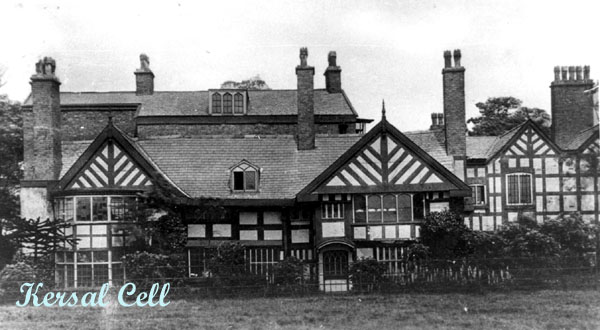
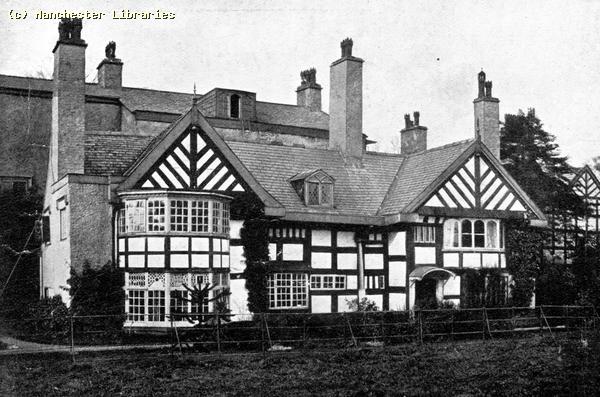
Below are three pictures of Kersal Cell in 1971. They show how pretty the building was and the area.
And finally you can see how green the area was in 1971. Roll your mouse over the image to see the same spot 42 years later on the 23rd January 2013.
A lovely picture from 1974. If you roll your mouse over the picture you can see the same spot 39 years later on the 23rd May 2013.
And two pictures from 1983. If you roll your mouse over the images below you can see the same views 30 years later on the 25th May 2013.
Kersal Cell and the cooling towers in 1986.
And again in 1986 in a pitiful state.
And two internal shots from 1986
A picture of Nigel Neil manager of the Greater Manchester Archaeological Unit in 1989 outside Kersal Cell. The building had been repeatedly broken into and vandalised and was on the brink of being destroyed entirely.
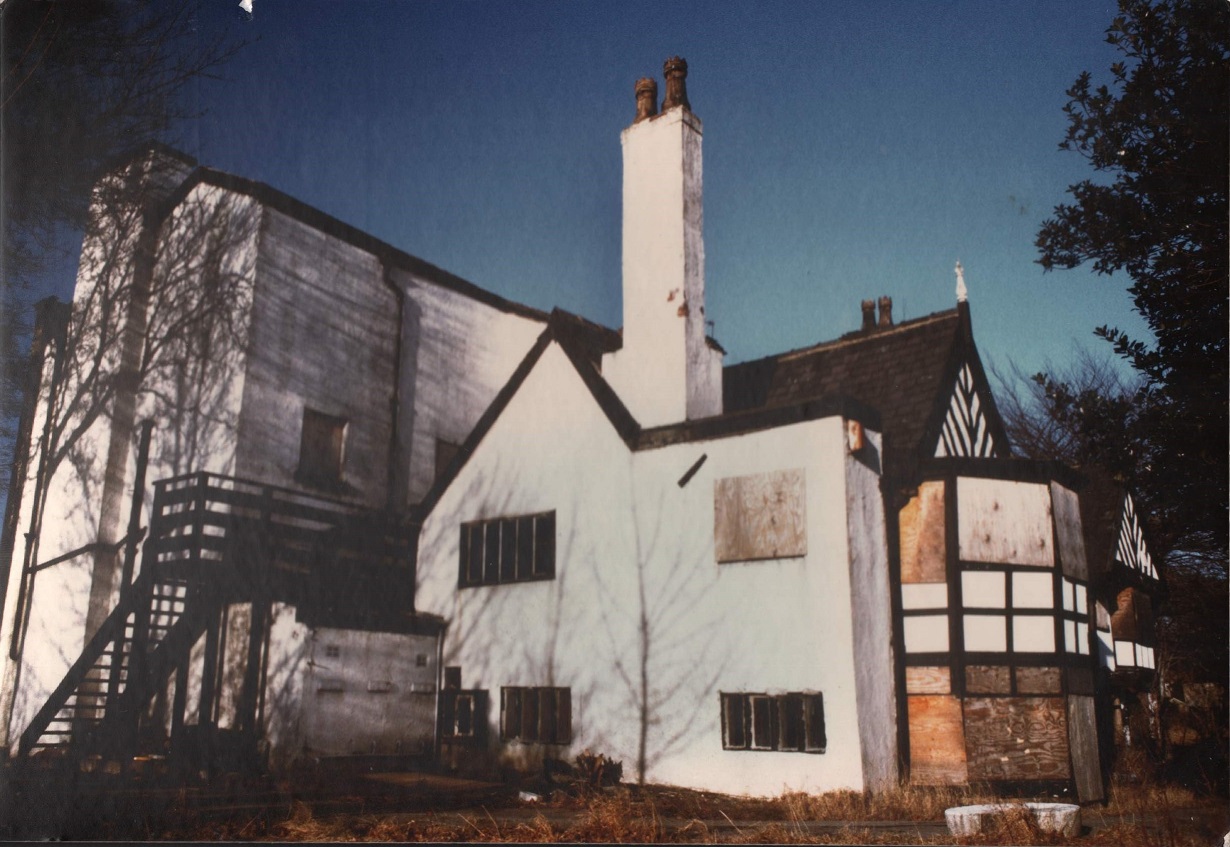
Another view of Kersal Cells boarded up and neglected.
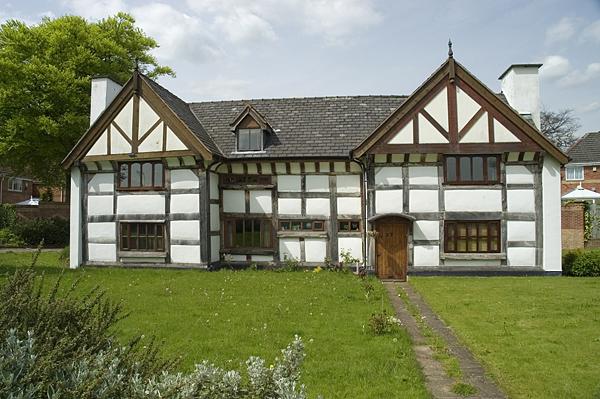
Finally, two 2008 pictures of Kersal Cell.
